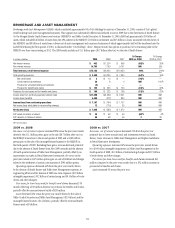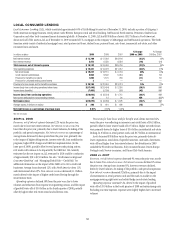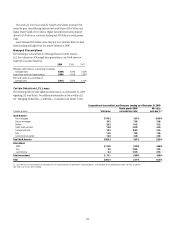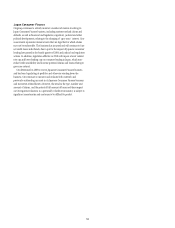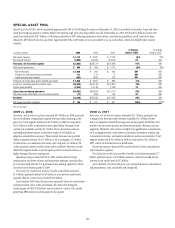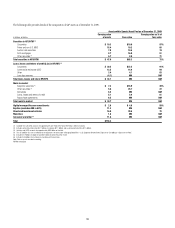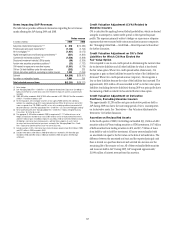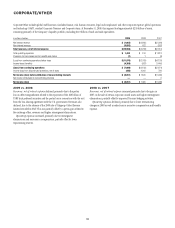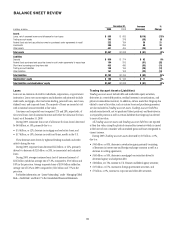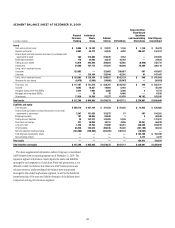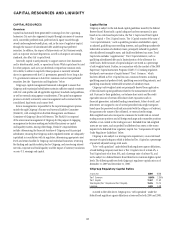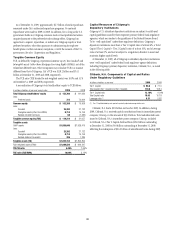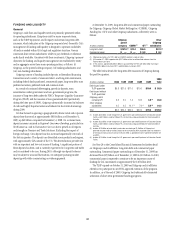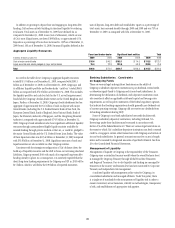Citibank 2009 Annual Report Download - page 50
Download and view the complete annual report
Please find page 50 of the 2009 Citibank annual report below. You can navigate through the pages in the report by either clicking on the pages listed below, or by using the keyword search tool below to find specific information within the annual report.40
Total average Trading account assets were $267 billion in 2009,
compared to $373 billion in 2008, yielding average rates of 4.0% and 4.7%,
respectively.
During 2009, Trading account liabilities decreased by $28 billion, or
17%, due to a:
$51 billion, or 44%, decrease in revaluation losses primarily due to •
decreases in interest rate, foreign exchange and equity contracts as well as
a decrease in netting agreements; and
$23 billion, or 45%, increase in securities sold, not yet purchased, •
comprised of an $18 billion increase in debt securities, with U.S. Treasury
securities increasing by $5 billion.
In 2009, average Trading account liabilities were $60 billion, yielding
an average rate of 0.5%, compared to $75 billion and 1.7% in the prior year.
For further discussion regarding Trading account assets and Trading
account liabilities, see Note 15 to the Consolidated Financial Statements.
Federal Funds Sold (Purchased) and Securities
Borrowed (Loaned) or Purchased (Sold) Under
Agreements to Resell (Repurchase)
Federal funds sold and federal funds purchased consist of unsecured
advances of excess balances in reserve accounts held at Federal Reserve
banks. When Citigroup advances federal funds to a third party, it is selling
its excess reserves. Similarly, when Citigroup receives federal funds, it is
purchasing reserves from a third party. These interest-bearing transactions
typically have an original maturity of one business day.
Securities borrowed and securities loaned are recorded at the amount of
cash advanced or received, with a minimal amount adjusted for fair value.
With respect to securities borrowed, Citi pays cash collateral in an amount in
excess of the market value of securities borrowed, and receives excess in the
case of securities loaned. Citigroup monitors the market value of securities
borrowed and loaned on a daily basis with additional collateral advanced
or obtained as necessary. Interest received or paid for these transactions is
recorded in interest income or interest expense.
Securities purchased under agreements to resell and securities sold under
agreements to repurchase are treated as collateralized financing transactions
and are primarily carried at fair value since January 1, 2007. Citigroup’s
policy is to take possession of securities purchased under agreements to resell.
The market value of securities to be repurchased and resold is monitored,
and additional collateral is obtained where appropriate to protect against
credit exposure.
During 2009, the increase of $38 billion, or 21%, in federal funds sold and
securities borrowed or purchased under agreements to resell, and the decrease
of $51 billion, or 25%, in federal funds purchased and securities loaned or
sold under agreements to repurchase were primarily driven by Citi’s liquidity
management objective of increasing cash and liquid securities positions.
For further information regarding these balance sheet categories, see
Note 13 to the Consolidated Financial Statements.
Investments
Investments consist of debt and equity securities that are available-for-sale,
debt securities that are held-to-maturity, non-marketable equity securities
that are carried at fair value, and non-marketable equity securities carried
at cost. Debt securities include bonds, notes and redeemable preferred stock,
as well as loan-backed securities (such as mortgage-backed securities) and
other structured notes. Marketable and non-marketable equity securities
carried at fair value include common and nonredeemable preferred stock.
These instruments provide Citi with long-term investment opportunities
while in most cases remaining relatively liquid.
Non-marketable equity securities carried at cost primarily include equity
shares issued by the Federal Reserve Bank and the Federal Home Loan Bank
that Citigroup is required to hold.
Investment securities classified as available-for-sale are primarily
carried at fair value with the changes in fair value generally recognized in
stockholders’ equity (accumulated other comprehensive income). Declines
in fair value that are deemed other-than-temporary, as well as gains and
losses from the sale of these investment securities, are recognized in current
earnings. Certain investments in non-marketable equity securities and
certain investments that would otherwise be accounted for using the equity
method are carried at fair value. Changes in fair value of such investments
are recorded in earnings. Debt securities classified as held-to-maturity are
carried at cost unless a decline in fair value below cost is deemed other-than-
temporary, in which case such a decline is recorded in current earnings.
During 2009, investments increased by $50 billion, or 20%, principally
due to a:
$6• 4 billion increase in available-for-sale securities (U.S. Treasury and
federal agency securities, $30 billion; foreign governments, $22 billion;
and corporate, $10 billion); and
$13 billion decrease in held-to-maturity securities• (predominantly asset-
backed securities).
For further information regarding investments, see Note 16 to the
Consolidated Financial Statements.
Other Assets
Other assets are composed of cash and due from banks, deposits with banks,
brokerage receivables, goodwill, intangibles, and various other assets.
During 2009, Other assets decreased $24 billion, or 5%, due to a:
$11 billion decrease in • Brokerage receivables, driven by the absence of
unsettled customer trades as markets have become more liquid;
$5 billion decrease in • Intangible assets and $2 billion decrease in
Goodwill, predominantly from the sale of Nikko Cordial Securities and
Nikko Asset Management and the MSSB JV with Morgan Stanley;
$3 billion decrease in • Deposits with banks, from decreased deposits with
the Federal Reserve used to purchase highly liquid securities; and
$5 billion decrease in various other assets.•
For further information regarding Goodwill and Intangible assets, see
Note 19 to the Consolidated Financial Statements. For further discussion
on Brokerage receivables, see Note 14 to the Consolidated Financial
Statements.



